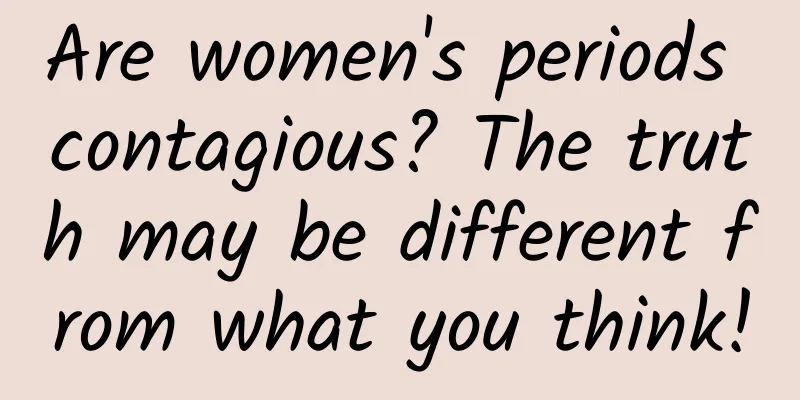Are women's periods contagious? The truth may be different from what you think!

|
There are usually two reasons why menstruation appears in movies and TV shows: First, tell the audience that a character's period is late, thus introducing a pregnancy storyline; Second, it tells the audience that the two characters’ menstrual cycles are synchronized, indicating that they have a close relationship or have been together for a long time. In fact, menstrual synchronization is a very unlikely phenomenon, and it does not exist that several people have synchronized menstruation due to long-term contact. However, menstrual synchronization is still a topic that women often talk about privately. Copyright images in the gallery. Reprinting and using them may lead to copyright disputes. In part, the myth persists because many people want it to be true. However inaccurate it may be, there’s something mysterious, otherworldly about the idea that women’s bodies have a collective rhythm that lends the myth further inertia, offering women a way to connect with other women, empathize, and collectively empower themselves. 01 Research on menstrual synchronization has holes The concept of menstrual synchronization was first proposed by a researcher named Martha McClintock in 1971 and has gradually become known to the public. Her study on menstrual cycle patterns, published in the journal Nature, tracked 135 female college students who lived in the same dormitory for six months and found a "significant increase in synchrony" between roommates and close friends, meaning that the differences in the start of their periods decreased. At the beginning of the study, the average difference in the start of menstruation between friends was six and a half days, but by the end of the study, the average difference was less than five days. By 1978, McClintock's work had been cited more than 40 times in other journals and scholarly works. This figure was raised by the late University of Missouri anthropologist H. Clyde Wilson Jr., who pointed out the flaws in McClintock's work in a 1992 paper. He pointed out multiple methodological oversights and noted that, although two subsequent experiments with similar designs had similar findings, four other subsequent experiments failed to replicate her results. Copyright images in the gallery. Reprinting and using them may lead to copyright disputes. Other researchers have taken this criticism a step further, including University of Michigan anthropologist Beverly Strassmann, who pointed out the basic logical fallacy of the menstrual synchronization research in a 1999 paper published in the journal Human Reproduction: “If two women have 28-day cycles, the maximum number of days they can be out of sync is 14 and the minimum is zero. Across women, the average difference in when their periods start is seven days, and half the time it’s less than seven days. Given that menstruation usually lasts five days, it’s not surprising that women’s periods often overlap, but this is often seen as evidence of menstrual synchrony.” That means women often have their periods at the same time as other women, so it's easy to mistake overlapping periods for synchronization, Strassman said in an interview. "By chance, two women's periods overlap one quarter of the time," she said. Copyright images in the gallery. Reprinting and using them may lead to copyright disputes. People may consciously or unconsciously ignore evidence that does not support their hypothesis, and this confirmation bias may also lead to this erroneous perception. On the other hand, because menstruation is a private matter, women rarely know how many strangers around them are menstruating at the same time. In addition, when two women are close enough to tell each other that they are menstruating, the overlap of their menstrual cycles can make them feel a mysterious, sisterly relationship. Strassman believes the myth of menstrual synchronization has been "debunked," but most people still believe it's true because it's "an appealing concept that transcends science." 02 Despite this, women still Believe in its existence In 2016, Breanne Fahs, a professor of women’s and gender studies at Arizona State University, published research on the claim. Fahs spoke with 18 women who believed they experienced menstrual synchronization and found several recurring themes. Some women believe that menstrual synchronization is biological, like animals, or influenced by hormones. In other words, it is a natural, primitive phenomenon that exists in the human body to promote the survival of the species. Other women believe that menstrual synchronization is real, but beyond the scope of scientific explanation. Some women even compare it to a mysterious, invisible connection between two women. Copyright images in the gallery. Reprinting and using them may lead to copyright disputes. Fass also found that some women believe that when a group of female friends spend a lot of time together, their menstrual cycles will sync up with a particular woman because they sense her "dominance" and adjust accordingly, just as sunflowers turn toward the sun. "(This idea) seems very strange, but it also fits with the way we think about social groups and social dynamics," Fass said. "Our culture does think a lot about things like dominance, hierarchy, social groups." However, Fass believes her main takeaway from the research is that experiencing menstrual pain together satisfies women’s need to belong in a community. “Women said that menstrual synchronization allowed them to express anger with other women. Anger became a platform for women to come together as a group, to raise their demands and to be more resolute.” Copyright images in the gallery. Reprinting and using them may lead to copyright disputes. One woman interviewed spoke fondly of the feeling she had when she and her best friend started menstruating at the same time, describing it as a sense of solidarity in the sense of “don’t mess with us.” Fass noted that this feeling can give women a sense of power when they express anger publicly, especially as a group, often face hostility or ridicule. Another reason the menstrual sync myth persists, Fass found, is that women have become accustomed to the medical establishment dismissing their feelings about their bodies, that doctors dismiss their patients’ pain and discomfort as if they were imagining it. Likewise, despite skepticism from some doctors and researchers, women (and men) have for decades believed that hormonal contraceptives cause weight gain and that an upcoming period can cause irritability, based on firsthand experience, women’s own observations of their own lives, and the support of some scientists. Copyright images in the gallery. Reprinting and using them may lead to copyright disputes. So when Fass presented research on women’s attitudes toward period synchronization at a menstrual research and advocacy conference a few years ago and mentioned that period synchronization had no scientific support, she received a backlash. Others at the conference insisted that scientists were biased on the issue. “Women’s feelings about their bodies are often ignored,” Fass said, “so people want to believe that [period synchronization] is real.” Source: Guokr The cover image and the images in this article are from the copyright library Reprinting may lead to copyright disputes |
Recommend
How can we effectively improve ROI if we don’t do monitoring and analysis for app promotion?
Local promotion is an effective way for App to ac...
Xiaohongshu marketing promotion, 13 tips for hot-selling notes!
In January 2019, the number of Xiaohongshu users ...
"April snow" is actually related to gender imbalance? Henan is formulating the first technical guide for prevention and control
In early summer, the catkins of willow trees in Z...
How to plan and promote an excellent event?
Whether you are doing user operations, new media ...
Don't turn the pages! Tell me right now, which plants can be used for dyeing?
"Remembering the green skirt, I pity the fra...
All the marketing tactics for Labor Day are here!
Labor Day is here again. Are you ready for this y...
App commercialization principles and advertising space optimization!
When we come into contact with APP developers, we...
Will you get more wet walking in the rain or running in the rain?
If it rains one day and you don’t have an umbrell...
The secrets of Douyin’s tens of millions of DOU+ placements
When operating a Tik Tok account, what you look f...
Android and Chrome OS become friends
[[119829]] This summer's Google I/O was almos...
Apple releases the user source function, which may completely reshuffle everything from channels to data monitoring!
Careful developers have discovered that Apple rec...
Practical review: How to operate a community and achieve revenue of over one million?
This article is based on a complete review of my ...
How did the ancients prevent fire during the Qin and Han dynasties?
The Qin and Han dynasties are collectively known ...
The cost of iPhone 12 was suddenly exposed, only more than 2,400 yuan, and the profit was so huge
As a high-end mobile phone brand, Apple has alway...
Three major principles in the user operation system!
This article introduces the three major principle...









